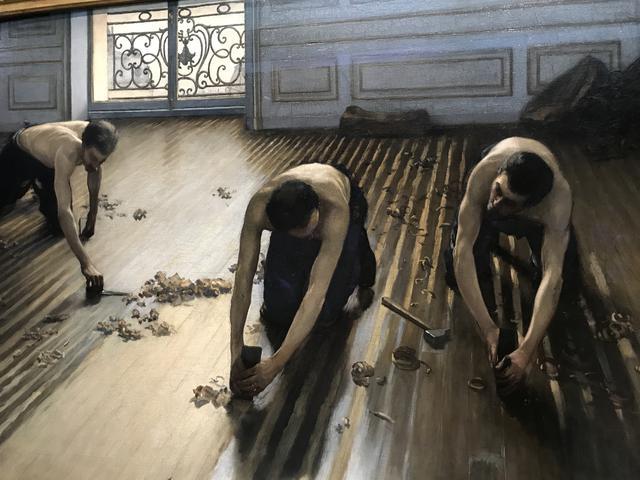Parquet Slashers

The Parquet Slashers is a captivating painting by Gustave Caillebotte that offers a unique glimpse into the daily lives of urban artisans in 19th century Paris. This masterpiece showcases Caillebotte's ability to capture the essence of modernization and social change during this period. The painting depicts a group of workers diligently cutting parquet flooring in a Parisian home, highlighting the industrialization and urbanization that was transforming the city at the time.
Caillebotte's decision to portray the urban proletariat in his work was groundbreaking, as it challenged traditional artistic conventions and brought attention to the working class in a way that had not been done before. The artist's realistic style and attention to detail give the painting a sense of authenticity and immediacy, making it a powerful commentary on the social and economic realities of the time.
Originally rejected when it was first introduced in 1875, the Parquet Slashers faced criticism from the bourgeois elite who were not accustomed to seeing such subjects depicted in art. However, Caillebotte's persistence paid off when he presented the painting again in 1876, this time alongside the Impressionists who embraced his innovative approach to capturing everyday life. The painting's inclusion in the Impressionist exhibition marked a turning point in Caillebotte's career, solidifying his reputation as a pioneering artist of his time.
The Parquet Slashers stands out not only for its subject matter but also for its technical mastery. Caillebotte's use of light and shadow, as well as his precise brushwork, create a sense of depth and dimension that brings the scene to life. The composition of the painting, with its carefully arranged figures and detailed interior setting, invites viewers to step into the world of the workers and experience their labor firsthand.
As a must-see point of interest for art enthusiasts and history buffs alike, the Parquet Slashers offers a window into a pivotal moment in French art and society. Through this painting, Caillebotte invites us to reflect on the impact of industrialization, urbanization, and social change on the lives of ordinary people, reminding us of the enduring power of art to illuminate the human experience.
© ChatGPT 3.5
This painting was part of a lot of forty-five paintings by painters of the caliber of Camille Pissarro, Pierre-Auguste Renoir and Alfred Sisley, who later sold their works to the Hotel Drouot. It was not until 1894 that Caillebotte was able to recover his painting after having long regretted having sold it.
An interesting detail about Caillebotte is that he does not sell paintings and that is why he was not recognized until the 20th century when he had already died. In fact he was the patron of several painters and at some point he put together an impressive collection of impressionist paintings. In fact this collection is the basis of the Orsay Museum.
The Parquet Stabbers is considered the first painting where the characters are not part of the rural proletariat, but are workers from the large cities of that time. Although it is also important to recognize that not many reflected manual work in their paintings.
Originally the French State, to whom Caillebotte had inherited his work and collection when he died in 1894, rejected the collection and it was not until two years later that they began to partially accept the paintings. This was due to pressure from various academics, who considered that the paintings were mostly vulgar because they represented the reality of common people.